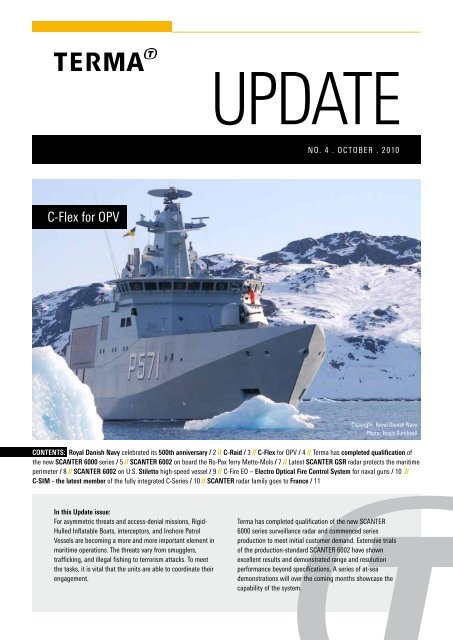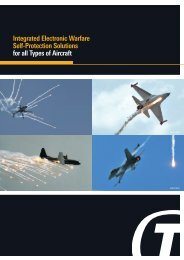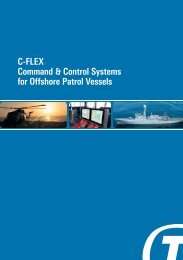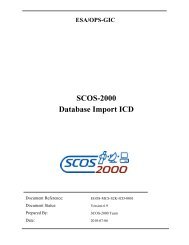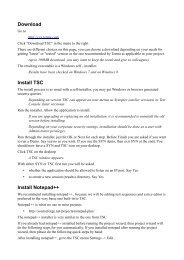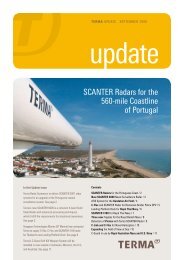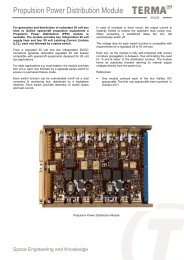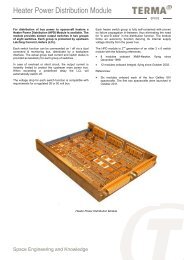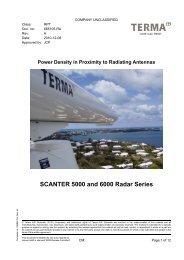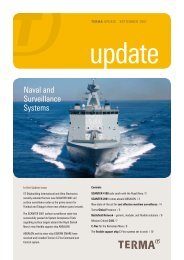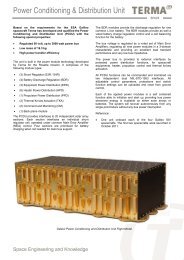C-Flex for OPV - terma
C-Flex for OPV - terma
C-Flex for OPV - terma
- No tags were found...
Create successful ePaper yourself
Turn your PDF publications into a flip-book with our unique Google optimized e-Paper software.
NO. 4 . OCTOBER . 2010C-<strong>Flex</strong> <strong>for</strong> <strong>OPV</strong>Copyright: Royal Danish NavyPhoto: Troels SundwallContents: Royal Danish Navy celebrated its 500th anniversary / 2 // C-Raid / 3 // C-<strong>Flex</strong> <strong>for</strong> <strong>OPV</strong> / 4 // Terma has completed qualification ofthe new SCANTER 6000 series / 5 // SCANTER 6002 on board the Ro-Pax ferry Mette-Mols / 7 // Latest SCANTER GSR radar protects the maritimeperimeter / 8 // SCANTER 6002 on U.S. Stiletto high-speed vessel / 9 // C-Fire EO – Electro Optical Fire Control System <strong>for</strong> naval guns / 10 //C-SIM - the latest member of the fully integrated C-Series / 10 // SCANTER radar family goes to France / 11In this Update issue:For asymmetric threats and access-denial missions, Rigid-Hulled Inflatable Boats, interceptors, and Inshore PatrolVessels are becoming a more and more important element inmaritime operations. The threats vary from smugglers,trafficking, and illegal fishing to terrorism attacks. To meetthe tasks, it is vital that the units are able to coordinate theirengagement.Terma has completed qualification of the new SCANTER6000 series surveillance radar and commenced seriesproduction to meet initial customer demand. Extensive trialsof the production-standard SCANTER 6002 have shownexcellent results and demonstrated range and resolutionper<strong>for</strong>mance beyond specifications. A series of at-seademonstrations will over the coming months showcase thecapability of the system.
Royal Danish Navy celebratedits 500th anniversaryThe Royal Danish Navy (RDN) turned a historic corner on 10August 2010. On this day, the RDN celebrated its 500thanniversary, and this was done in style in Copenhagen. Inthe week surrounding this big day, nearly 50 national andinternational navy ships visited Copenhagen to honor theNavy. Terma was of course present on board the HDMSABSALON, where we demonstrated many of our capabilities,including C-<strong>Flex</strong>, C-Raid, C-Guard, SCANTER radar, andBMD-<strong>Flex</strong>. Terma also hosted and demonstrated an antipiracyoperation combining the capabilities of C-<strong>Flex</strong>, C-Raid,and SCANTER radar <strong>for</strong> the many Chiefs of Navies who werepresent.2 TERMA UPDATE . NO. 4 . OCTOBER . 2010
C-Raid – Command & Control System<strong>for</strong> small maritime unitsFor asymmetric threats and access-denial missions withinthe Economic Exclusion Zone (EEZ), Rigid-Hulled InflatableBoats (RHIB), interceptors, and Inshore Patrol Vessels (IPV)are becoming a more and more important element inmaritime operations. The threat level, faced by these boatclasses, varies from smugglers, trafficking, and illegal fishingto terrorism attacks. To meet the tasks, it is of vital importancethat the units are able to coordinate their engagement.As of today, most of these small units only have onboardnavigation and voice communication systems. Full missioncoordination requires a tactical, joint overview of all units inthe area <strong>for</strong> maximum efficiency and minimum collateraldamage.Terma has developed a system named C-Raid supportingthese operations by offering real-time situational awarenessand command & control capabilities to the small units at sea.The system provides greater interoperability between multipleunits making mission scenarios like coastal patrolling,Search & Rescue (SAR), and maritime boarding operationsmore effective. As part of the design, the functionality spansso widely that Special Operations Forces (SOF) also findC-Raid a valuable asset <strong>for</strong> their maritime missions.Typical usage includes a tactical operation center placedeither on a larger vessel or on shore, commanding thesmaller maritime units in theatre. The C-Raid system onboard supports the commander by providing automatic, realtimeupdates of maritime activity received from sensors suchas AIS, ARPA, and FLIR systems, thus making decisionprocesses more effective and accurate. An example could bea smuggler trying to reach the coast line without gettingcaught by the patrolling vessels. The commander is able tosend the pursuing vessels to the optimal position in order tointercept the smuggler be<strong>for</strong>e he escapes or unloads thecargo at the coast.The boat operator will experience a compact command &control system providing a complete Common OperationalPicture (COP) with all tracks in the area. Each track representsa maritime unit and its present speed and course aswell as history path. Even in extreme weather conditions, theoperator will still be able to use the intuitive, touch inputdisplay to address the relevant tracking and surveillancein<strong>for</strong>mation shared between deployed units. Human errorsare reduced due to easy on-screen commands and integratedblue <strong>for</strong>ce tracking, which in the end will save lives byenabling the operators to clearly distinguish between own<strong>for</strong>ces and threats.The system is built around a Network Based Operations(NBO) philosophy which ties multiple units together viacommunication links exchanging track data and messages.Compared to traditional voice communication, theNBO-concept widely expands the operational potential andmission effectiveness by integrating even the smallestnetworked units in the situational overview.C-Raid is one of the first movers in the market withincommand & control systems <strong>for</strong> smaller maritime units, andTerma benefits from being a mission-critical supplier ofcommand & control systems <strong>for</strong> larger naval vessels <strong>for</strong> morethan two decades.TERMA UPDATE . NO. 4 . OCTOBER . 2010 3
Copyright: Royal Danish NavyC-<strong>Flex</strong> <strong>for</strong> <strong>OPV</strong>C-FLEX <strong>OPV</strong> takes the per<strong>for</strong>mance of a high-end combatsystem into the <strong>OPV</strong> and offers a superior per<strong>for</strong>mance atan attractive price.Combined with the C-SEARCH radars and C-FIRE EO FireControl, it becomes a potent command & control systemtailored <strong>for</strong> patrol ships.The C-<strong>Flex</strong> system allows complete control of all sensorsfrom the multifunction consoles and provides track management,sensor fusion, and identification facilities. The importantsituation display has elaborate graphical features andoverlays of ECDIS charts, radar video, operator generatedmaps and patterns, and track in<strong>for</strong>mation. The operator hasaccess to a full set of management totes and screen-tools,which can be individually tailored, and he may control andmonitor all interfaced systems. The system can also displayvarious video sources like raw radar, EO picture, internalcameras, etc. The system has extensive data and videorecording facilities to support the law en<strong>for</strong>cement role withreconstructions and reporting that will stand up in a court oflaw.4 TERMA UPDATE . NO. 4 . OCTOBER . 2010
Terma has completed qualificationof the new SCANTER 6000 seriesTerma has completed qualification of its new SCANTER6000 series surveillance radar and commenced seriesproduction to meet initial customer demand.that overcomes the limitations of previous generation radarsso as to reliably detect small targets in high sea and weatherclutter backgrounds.Radar and qualification activities are now complete.Extensive land-based trials of the production-standardSCANTER 6002 have shown excellent results and demonstratedrange and resolution per<strong>for</strong>mance beyond specifications.In parallel, a series of at-sea demonstrations will over thecoming months showcase the capability of the system toprospective customers among navies, coast guards, andmaritime surveillance agencies.Launched to market in 2009, the SCANTER 6002 is a coherentX-band 2D solid state radar developed to addressmarket requirements <strong>for</strong> improved surface and low airspacesituational awareness. It has been specifically designed asan af<strong>for</strong>dable all-weather sensor solution to plug the gapbetween standard marine navigation radars and more expensivemilitary surveillance radar systems.Building on over 60 years of maritime radar experience, theSCANTER 6002 system delivers exceptional per<strong>for</strong>mancethrough the application of advanced hardware design andintelligent processing. The result is a state-of-the-art sensorTechnologySCANTER 6002 is based on a new low voltage/low temperature200 W solid-state transmitter architecture and a noveldual-channel processing chain. It is a fully coherent radaremploying a range of software-defined processingtechniques so as to enable excellent high definition per<strong>for</strong>mance– from very close range right out to the limit of theradar horizon – to satisfy a range of tactical needs.Versatility is the key selling point <strong>for</strong> SCANTER 6002. Marketanalysis has indicated a growing requirement <strong>for</strong> a sensorthat can enhance surface/low altitude situational awarenessto support missions such as maritime interdiction operations,counter-narcotics, fisheries protection, helicopter control,and search and rescue. At the same time, SCANTER 6002also meets IMO standards <strong>for</strong> navigation.One stand-out feature of SCANTER 6002 is the use of parallelDoppler and normal radar processing channels. Theseprovide complementary benefits: exploitation of Doppler shiftenhances the detection of both air and surface targetsmoving radially and with velocity different from that of thebackground clutter; while the normal radar chain employs a»TERMA UPDATE . NO. 4 . OCTOBER . 2010 5
series of correlation and clutter processing techniquesincluding pulse compression, frequency and time diversityand FiveStepVideoPassing (Terma’s proprietary signal conditioningtechnique).This combination of proprietary correlation and adaptive MTIfiltering – respectively providing inter-clutter visibility andsub-clutter visibility – delivers significantly improved per<strong>for</strong>mancein rain and high sea states. Video data <strong>for</strong> theseparate air and surface channels can be combined to orpresented separately to the operator using an integratedparallel tracking system.User benefitsSo what does this mean <strong>for</strong> the radar operator? In short,SCANTER 6002 enables users to see what was previouslyunseen, using its advanced dual processing chain to detectsmall targets from clutter in all weather conditions.Furthermore, it offers application across a range of surveillancemissions.The secret to the very high resolution of the radar at allranges is the very fine range cell size (3 m out to 48 NM, 6 mout to 96 NM) and a high dynamic range receiver. Thisprovides an exceptionally high level of fidelity allowing smalltargets to be detected even if they are attempting to’shadow’ themselves by maintaining a position close to a farlarger radar contact.Another key discriminator <strong>for</strong> SCANTER 6000 lies in itssimplicity of operation. It only requires the operator to selecta profile in range and domain (air or surface); thereafter thesystem is adaptive to the prevailing weather and clutterconditions, automatically adjusting radar parameters so as tooptimize per<strong>for</strong>mance according to the instrumented rangesetting.So in the broadest terms, SCANTER 6002 delivers muchimproved situational awareness by automatically detectingand tracking surface and low altitude air targets that wouldbe masked by clutter to a conventional radar system. Thecombined effect is to reduce the workload <strong>for</strong> the operator,and provide the ship command with a better appreciation ofthe maritime picture and more time to make tacticaldecisions.Looking in more detail, SCANTER 6002 can be employed as aself-protection sensor, using correlation algorithms(supported by coherent processing) to provide timely detectionof small surface threats. In this mode, the antennarotation rate may be increased to improve picture refresh andmaximize the time available <strong>for</strong> classification, threat assessment,and deployment of the appropriate defensivemeasures.For helicopter control, SCANTER 6002 uses coherent MTItechniques in combination with small target detectiontechniques. This significantly increases the range at whichrotary-wing aircraft (and Unmanned Aerial Vehicles) can betracked during launch and recovery operations.»6 TERMA UPDATE . NO. 4 . OCTOBER . 2010
In addition, the capability of SCANTER 6002 to detect smalltargets (in combination with helicopter control) makes it verywell suited <strong>for</strong> SAR operations. While Doppler shift is used tomaintain a track on the helicopter, correlation algorithms andCFAR are employed to improve detection per<strong>for</strong>mance ofsmall targets in distress and cooperative surface vessels(given that these have returns similar to the amplitude of thebackground clutter).Finally, the normal radar mode – augmented by Dopplerreturns – provides support to safe navigation in accordancewith latest IMO standards.Terma has commenced series manufacture of the shipborneSCANTER 6002 and the equivalent land-based SCANTER5000 series coastal surveillance/VTS radar. Over 30 ordershave already been secured from customers in Europe and theMiddle East.SCANTER 6002 on board theRo-Pax ferry Mette-MolsTerma has recently installed its latest SCANTER 6002 onboard the Ro-Pax ferry Mette-Mols <strong>for</strong> an initial period ofat-sea trials and demonstrations.Owned and operated by Mols Linien – a Danish ferry company,and sailing between the cities of Aarhus and Kalundborg,Mette-Mols offers an ideal plat<strong>for</strong>m from which to showcasethe capabilities of the SCANTER 6002 system at sea.For example, its large open topside area allows <strong>for</strong> theoptimal siting of two separate antennas, thereby allowingboth surface and low altitude air pictures to be presentedsimultaneously.targets. Furthermore, the regular routing means that testscan be repeated in different weather and sea states.Another benefit to Terma is the close proximity of its radarbusiness to the ferry terminal at Aarhus. This means thatcompany engineers can easily access the vessel to per<strong>for</strong>mtests and trials, and also enables existing and prospectivecustomers to be embarked to witness SCANTER 6002 inoperation at sea.Furthermore, the ferry transits a littoral zone crowded withshipping and air traffic. Sailing time in each direction isalmost 3 hours, which provides plenty of time <strong>for</strong> trackingtargets of opportunity as well as surface and air controlledTERMA UPDATE . NO. 4 . OCTOBER . 2010 7
Latest SCANTER GSR radarprotects the maritime perimeterThe SCANTER Ground Surveillance Radar (GSR) system, asthe latest addition to Terma’s SCANTER radar family, brings anew dimension to perimeter surveillance <strong>for</strong> naval bases,ports, and other critical coastal infrastructures. Operating inthe Ku-band, the system is a short-to-medium range surveillancesensor designed to per<strong>for</strong>m 360° search and detectionof humans and other small moving targets in clutter-filledenvironments.Weighing less than 30 kg, SCANTER GSR comprises a highresolutionpulse-Doppler radar sensor, a processinghardware unit, rotating mechanics, and an Internet Protocol(IP) connection. All necessary interfaces are via IP links; thesystem can co-exist on a switched or routed local areanetwork with other units.SCANTER GSR functions in two modes simultaneously: as aDoppler radar it detects movements in the presence of highclutter, while as a high resolution radar it measures withhigh precision to discriminate between targets close to oneanother. Precise angle and distance measurement permitsthe definition of alarm areas with less than 1 m resolution.Low power (8 W maximum) and high frequency contribute toa low probability of interception. In addition, the radarapplies high-resolution frequency-hopping modulation,coherent detection, Doppler speed measurement, andimproved signal-to-noise ratio by applying digital signalprocessing.8 TERMA UPDATE . NO. 4 . OCTOBER . 2010
SCANTER 6002 onU.S. Stiletto high-speed vesselTerma’s latest SCANTER 6002 radar is to be installed onboard the U.S. Department of Defense’s Stiletto highspeedvessel testbed.An advanced high-speed multi-hull vessel being used by theU.S. Navy’s Southern Command (SOUTHCOM) is being fittedwith the new SCANTER 6002 solid-state radar to enhance itssituational awareness capability.The M80 Stiletto testbed is a stealthy, all-composite shallowdraft ‘seaframe’ based on a novel M-hull design originallydeveloped <strong>for</strong> the Department of Defense’s Office <strong>for</strong> ForceTrans<strong>for</strong>mation. The vessel is 88 ft in length, 40 ft in beam,and designed <strong>for</strong> a speed of 50-60 knots.Stiletto is already equipped with Terma’s SCANTER 2001radar. The addition of SCANTER 6002 will provide the vesselwith an extended range high definition surface picture aswell as a capability to monitor low altitude air targets –important capabilities <strong>for</strong> counter-narcotics operations in theSOUTHCOM area of operations.SCANTER 6002 will be installed on board Stiletto inNovember, marking the first delivery of the type in NorthAmerica. Both the navigation and tactical surveillancepictures will be presented on a radar display system providedby GTEC.TERMA UPDATE . NO. 4 . OCTOBER . 2010 9
SCANTER radar familygoes to France© DCNA new offshore patrol vessel (<strong>OPV</strong>) being built as a privateventure by France’s DCNS will rely on Terma’s SCANTERradar family <strong>for</strong> comprehensive situational awareness.Now building at Lorient, the 87 metre <strong>OPV</strong> – to be namedHermes – will be used by DCNS as a showcase <strong>for</strong> its newfamily of Gowind maritime protection vessels. It will becomeoperational in late 2011, being initially crewed by the FrenchNavy <strong>for</strong> a series of capability demonstrations.As a partner to DCNS, Terma will supply both its SCANTER4102 and SCANTER 6002 surveillance radars to providegapless surface and air coverage. The two systems will sharea single 10 ft high gain antenna mounted inside a conicalradar transparent mast structure.The combination of SCANTER 4102 and SCANTER 6002 willprovide Hermes with complementary capabilities <strong>for</strong>all-round situational awareness. For example, the TWT-basedSCANTER 4102 will provide excellent medium range surveillancein both the air and surface channels, with the capabilityto track large aircraft at ranges out to 80-90 NM.Meanwhile, the solid-state SCANTER 6002 will provide near,low air, and surface surveillance. Its utility will include thedetection and tracking of potential low RCS ‘asymmetric’threats, helicopter control, search and rescue, and navigationsupport.Radar hardware delivery to the DCNS shipyard at Lorient willtake place in the spring of 2011. Terma’s position on boardHermes reflects the continuing strong relationship betweenthe company and DCNS, which goes back to the supply ofthe SCANTER 2001 radar <strong>for</strong> the Project Delta export frigateprogram.TERMA UPDATE . NO. 4 . OCTOBER . 2010 11


